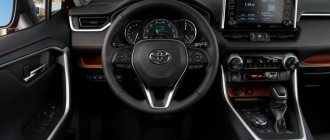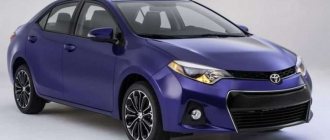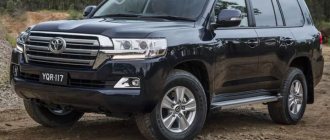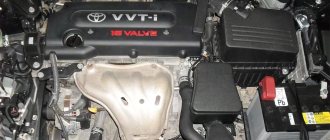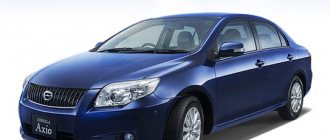3260 Apr 20
The premiere of the new Camry 2014 took place in the USA, and a little later the manufacturer presented the European version. However, future buyers could see the car at an exhibition in Detroit a year ago. Toyota never got anything in common with the concept, but most of its characteristics did not upset fans of the brand.
It is worth noting that the appearance of European and American cars differs significantly, therefore their overall dimensions will be different.
The value of dimensions during operation
The larger the car, the more difficult it is to drive, the more clumsy it behaves on the road and has difficulties with parking issues, however, as the size increases, the level of safe operation increases. When any situation arises on the road, the driver must have a great sense of the scale of the “horse” in order to promptly avoid an emergency situation, confidently and quickly occupy a parking space, and skillfully drive the vehicle in traffic jams.
White Camry 55 on top and 70 on bottom
For novice car enthusiasts, the most effective way to feel the scale is regular practice and the ability to correctly use information from the side mirrors. In particular, the importance of side mirrors cannot be overestimated when parking in reverse. Driving schools practice special exercises, the completion of which allows the car enthusiast to feel the size of the car much more effectively and feel more confident on the road in the most difficult situations.
Camry XV50 for the American, Russian and Japanese markets.
Difficulties with feeling the size of their “horse” are often experienced not only by novice drivers, but also by experienced car owners when purchasing a new car, especially when changing the type, for example, from a sedan to an SUV or minivan.
Streamlining or drag directly affects not only speed, but also fuel consumption, stability and operational safety. The drag coefficient is determined by the manufacturer in a special wind tunnel or using computer simulation.
Comparison of Toyota Camry 2021 trim levels
| Standard 2.0L | Standard Plus 2.0L | Classic 2.0L | Comfort 2.5L | Elegance 2.5L | Elegance Plus 2.5L | Prestige 2.5L | Elegance Drive 3.5L | Luxe 3.5L | |
| Minimum price, rubles | 1 364 000 | 1 419 000 | 1 484 000 | 1 516 000 | 1 599 000 | 1 635 000 | 1 736 000 | 1 816 000 | 1 960 000 |
| Anti-lock braking system (ABS) | + | + | + | + | + | + | + | + | + |
| Adaptive headlights | No | No | No | No | No | No | No | No | + |
| On-board computer | + | + | + | + | + | + | + | + | + |
| Rain sensor | No | + | + | + | + | + | + | + | + |
| Light sensor | + | + | + | + | + | + | + | + | + |
| Central locking remote control | + | + | + | + | + | + | + | + | + |
| Rear electric windows | + | + | + | + | + | + | + | + | + |
| Rear View Camera | No | + | + | + | + | + | + | + | + |
| Climate control | + | + | + | + | + | + | + | + | + |
| Leather interior | No | No | + | No | + | + | + | + | + |
| Number of airbags | 8 | 8 | 8 | 8 | 8 | 8 | 8 | 8 | 11 |
| Xenon/bi-xenon headlights | No | No | No | No | No | + | + | + | + |
| Alloy wheels | + | + | + | + | + | + | + | + | + |
| Heated mirrors | + | + | + | + | + | + | + | + | + |
| Passive cruise control | No | + | + | No | + | + | + | + | + |
| Front electric windows | + | + | + | + | + | + | + | + | + |
| Heated seats | + | + | + | + | + | + | + | + | + |
| Fog lights | + | + | + | + | + | + | + | + | + |
| Adjusting the steering column | + | + | + | + | + | + | + | + | + |
| Adjusting the driver's seat height | + | + | + | + | + | + | + | + | + |
| Blind spot monitoring system | No | No | No | No | No | No | No | No | + |
| Stabilization system (ESP) | + | + | + | + | + | + | + | + | + |
| Folding rear seat | + | + | + | + | + | + | + | + | + |
| Power steering | + | + | + | + | + | + | + | + | + |
| central locking | + | + | + | + | + | + | + | + | + |
| Standard audio system with CD and MP3 support | + | + | + | + | + | + | + | + | + |
| Regular parking sensors | + | + | + | + | + | + | + | + | + |
| Electric front seats with memory settings | No | No | No | No | No | No | No | No | + |
| Power driver's or front seats | No | No | + | No | + | + | + | + | + |
| Electrically adjustable mirrors | + | + | + | + | + | + | + | + | + |
Improving Design
The developers began updating the model by restyling the appearance of the car. The company's specialists did a good job; they made some changes to the design. In total, 2 thousand parts underwent changes. In addition, the manufacturer states that the Toyota Camry 2021 (2017) in the new body will have a more original and comfortable interior. The materials used to decorate the interior have become softer and of higher quality. About 7 thousand American specialists worked on the design of the new car.
Camry Interior - Front Seats
Dashboard
Passenger seats - photos
This is interesting: Test drive Toyota Rav 4 2021 video 2L CVT all-wheel drive
Interior equipment
Soft plastic was used to decorate the dashboard; there is a wide console between the front seats with manual or electrical position adjustment.
The analog instrument cluster has an on-board computer screen; the standard equipment included a 2 Din multimedia center with a disc player and an automatic installation to maintain the microclimate in the cabin. The seats in the base had fabric covers; the other versions had artificial leather trim (black or beige).
What can you say about the appearance?
The first thing that catches your eye is the dimensions of the body: they have become noticeably larger. The car looks more impressive; its appearance and internal contents have changed significantly. The car became sporty, while remaining solid. It is perfect for business people who value style and comfort and want to emphasize their status. The elegance of the lines is emphasized by mirrors that fit well into the overall design.
The radius of the wheel arches is quite large and allows the installation of R17 wheels: large wheels make the car more aggressive, making it seem larger and more powerful
The style can be seen in absolutely everything: from the aggressive radiator grille with a large air intake to the tail section of the car, which attracts the attention of passers-by. Despite the heavy weight, the car does not look bulky, it creates a feeling of lightness, and controllability is also high
Toyota reacts to the slightest touch on the steering wheel, and driving it is not difficult.
Options and prices
| Standard | 1 407 000 | Standard Plus | 1 460 000 |
| Classic | 1 536 000 | Comfort | 1 557 000 |
| Elegance | 1 640 000 | Elegance Plus | 1 676 000 |
| Exclusive | 1 710 000 | Prestige | 1 782 000 |
| Elegance Drive | 1 865 000 | Lux | 2 009 000 |
The car is offered in three trim levels. They differ from each other in power units, since the “filling” in each version is approximately the same, with some minor optional improvements.
For the basic package, which includes all the necessary equipment and functions, you will have to pay at least 1,200,000 rubles.
The starting price of the average configuration is 100,000 rubles higher, and the only additions that can be noted are a more powerful power unit.
The Toyota Camry 2016-2017 model in the top configuration will cost the buyer 2,000,000 rubles. But, if you take a closer look at the equipment and characteristics of the model, then this is not a very large sum for a car of this level.
It is worth noting that each configuration has several more varieties, which also differ in engine type.
For example, there are three configuration options with a two-liter engine. The cost of each of them, starting with the youngest: 1,213,000 rubles, 1,287,000 rubles and 1,352,000 rubles.
Next there are four options with a 2.5-liter engine: 1,449,000 rubles, 1,531,000 rubles, 1,567,000 rubles and 1,668,000 rubles.
The most powerful are the last two, the most expensive configurations, which are equipped with a 3.5-liter engine with a capacity of 250 horsepower. Their cost is respectively 1,735,000 rubles and 1,880,000 rubles.
This is interesting: Toyota Camry 2021 when will there be sales in Russia: read point by point
Advantages and disadvantages according to the owners
The reviews left by the owners allow us to draw a conclusion about the reliability of the car’s design. For example, brake mechanisms require regular cleaning and lubrication of the caliper guides. The discs can travel up to 200 thousand km, but if the elements are constantly overheated (applies to cars with a 3.5-liter engine), then the service life drops by 5-6 times. The handbrake requires periodic tightening of the cables; to replace parts, partial disassembly of the center console trim is necessary.
The manufacturer did not provide a station wagon body for the XV40, but the strength of the suspensions is also insufficient for a sedan. For example, the alignment of the front wheels is disrupted after several trips on uneven roads. The service life of ball joints and shock absorbers does not exceed 150 thousand km; the anti-roll bar struts break after 40-50 thousand km.
At the same time, the steering does not require intervention; fluid leaks from the amplifier occur at mileages of more than 300 thousand km. There is a knocking sound from the spline connection in the steering column, which does not affect control accuracy. The design of the engines does not use 2-mass flywheels; the hydromechanical transmission requires regular replacement of the working fluid and filter. With an aggressive driving style, the clutch packs burn out and the bearing supports are destroyed. The manual transmission control link breaks, it is recommended to change the shift cables after 150-200 thousand kilometers. The disadvantage is the radiators of the cooling system, which rot after 8-10 years of operation. The service life of the piston group of the 2AZ and 2GR engines exceeds 350 thousand km.
Source
Dimensions of Camry XV10
Body parameters, namely width, height and length of the Toyota Camry XV10 are 1770, 1415 and 4725 mm, respectively. At the same time, the wheelbase is 2 m 61.8 cm, the distance between the front wheels is one and a half meters and 4.9 centimeters, and the rear is one and a half meters and 9.9 centimeters. Weight: 1355 kilograms. Aerodynamic drag coefficient: 0.31.
Camry XV10
The XV10 has more modest parameters, discussed in this material, in comparison with models of subsequent generations, however, their differences are not so significant that one has to talk about better handling on the road or more comfortable parking.
Machine Specifications
The 2008 Camry sedan had a streamlined body with an aerodynamic drag coefficient of 0.28 units. The car is equipped with front drive wheels (in the Russian Federation there are single examples of cars with all-wheel drive, imported by their owners from Japan).
The chassis design retains closed-type spatial subframes made of steel profiles. They were used to mount the arms and steering, providing increased rigidity.
The brake system with a vacuum booster had 2 diagonal circuits operating independently. If one of the lines broke down, the driver could stop the car with the remaining serviceable circuit.
In accordance with international safety requirements, the fuel tank is located inside the wheelbase. The tank held 70 liters of gasoline, the fuel was supplied by an electric pump through a separate filter. The luggage compartment had a volume of 504 liters (when installing an electric drive for the rear row of seats, the parameter was reduced to 468 liters).
Main settings
Machine characteristics (data given for version with 2GR engine):
- maximum speed - 230 km/h;
- acceleration time from zero to 100 km/h is about 7.4 seconds;
- cabin capacity - 5 people;
- turning radius (minimum) - 5.5 m;
- curb weight - 1540 kg;
- load weight - up to 510 kg;
- permissible vehicle weight - 2050 liters.
Dimensions
Car dimensions (Russian version):
- base - 2775 mm;
- front track width - 1575 mm;
- rear track width - 1565 mm;
- overhang length front and rear - 955 and 1085 mm;
- ground clearance - 160 mm;
- body width - 1820 mm;
- machine length - 4815 mm;
- height - 1480 mm.
Engine
The Russian market offered engines of the 2AZ-FE and 2GR-FE models with distributed gasoline injection and an exhaust emission reduction system in accordance with Euro-4 standards.
The base was a 4-cylinder 2AZ, developing 167 hp. With. at a crankshaft speed of 6000 rpm. The torque was 224 N*m at 4000 rpm. The engine had a VVT-i timing regulator and a 16-valve head with a pair of chain-driven camshafts.
For the Luxe model, the 2GR was offered, equipped with a V-shaped aluminum block with a 60° camber angle. Cast iron liners with channels between the walls of adjacent cylinders for antifreeze circulation were poured into the crankcase body.
The power unit was equipped with 12-valve heads with 2 camshafts. A VVT-i valve timing adjustment system was provided, the peak power was 277 hp. With. at 6200 rpm.
The working volume increased to 3.5 liters (for the 2AZ the parameter was 2.4 liters) made it possible to increase the torque plateau to 346 N*m at 4700 rpm.
Safety system
The basic security systems included:
- airbags in the dashboard, front seat backs and roof pillars;
- diagonal separate brake drive with ABS unit and electronic brake pressure distributor;
- inertial seat belts (tensioning pyrotechnic devices are provided in front);
- headrests with protection of the cervical spine from injury;
- ESP motion stabilization system;
- power bars in the doors and alloy steel inserts to protect against injuries in the event of a side impact;
- ultrasonic parking sensors in bumpers;
- system to prevent the drive wheels from slipping.
Fog lights in the front bumper were absent on the basic version; some owners installed the elements at the dealer or with their own hands.
An additional brake signal was installed by default under the rear window. Some modifications had light and rain sensors that automatically controlled external lighting and operating modes of windshield wipers. The rear sofa had Isofix fasteners for installing a child seat.
Facilities
Options for driver and passenger comfort:
- hydraulic power steering;
- interior rearview mirror with automatic dimming;
- adjustable steering column;
- sun visors with makeup mirrors;
- immobilizer with an identification chip located in the head of the ignition key;
- security alarm with remote control in the key;
- electric door lock drives;
- stepped heating of the front seats;
- electric drives of side windows in doors and rear-view mirrors;
- seat adjustment in several directions (including adjustment of lumbar support);
- folding backrest of the rear sofa (in the proportion of 60/40);
- armrests front and rear;
- air conditioning system with automatic maintenance of the set temperature (2 zones);
- protective coating on glass;
- system for maintaining a given speed;
- air ducts for ventilation of the rear compartment;
- full-fledged spare wheel on a cast disk;
- 6 loudspeakers installed in the doors and the top of the instrument panel;
- electric drive for adjusting the rear sofa (only for some cars with a 3.5-liter engine).
Comfortable salon
The dimensions and layout of the interior remain the same. The new finishing material has an original structure. Luxury versions have higher quality natural wood inlay. The original blue lighting in the lower part of the cabin replicates the backlighting of the instrument keys on the center console and doors. The driver has access to wireless charging for his mobile phone. Both front seats are equipped with a microlift and effective lateral support, which reliably holds the driver and passenger when bending at high speed.
Of the traditional analog instruments, only the speedometer with a fuel level indicator and the tachometer with a coolant temperature indicator remain. The 4.3-inch digital navigation display on the instrument panel is now compatible with the 7-inch multimedia system display. In addition to movement parameters, it displays information about the tracks being played or the current radio wave.
The basic version of the 2021 Toyota Camry is equipped with six airbags, a new generation ABS, an emergency braking warning system, ASR, BAS and ESP systems, and as options, blind spot monitoring systems and an on-board radar are offered, which allows you to detect obstacles on the roadway in advance.
Updated Toyota Camry sedan: what has changed?
The basic version with a two-liter engine of Toyota Camry sedans accounted for only 17% of sales. It was all the more surprising to meet the old Camry 2.0 at the driving presentation of the updated model in Spain. For comparison.
Instead of the well-deserved 1AZ-FE engine, which dates back to 2000, there is now a new two-liter “four” 6AR-FSE. Instead of a four-speed automatic transmission, there is finally a modern one with six gears, from more powerful versions. AND…
The claimed reduction in acceleration time to hundreds (from 12.5 to 10.4 s) was not confirmed. My colleagues and I deliberately arranged parallel starts - but the updated Camry was ahead of the previous maximum by half a length, and this is about one tenth of a second of winning. After all, the engine output has increased slightly: power - from 148 to 150 hp, and torque - from 190 to 199 Nm.
It also seemed to me that the hesitation when starting off in the updated car was a little more noticeable. But the new engine growls more solidly, and most importantly, the six-speed gearbox changes gears more quickly, reacts faster to moving the gas pedal and does not annoy you with jerks. Driving is more enjoyable! And if you believe the passport data, then fuel consumption should decrease - by an average of 13%.
The interior has become prettier, the quality of plastic has improved, but the tacky pseudo-wood and the play of some parts have not gone away. Sound insulation has been improved: there are new sound-absorbing materials under the floor, and additional inserts in the front doors
All other changes, according to the Japanese, were made “at the request of customers.” Don't like the instrument cluster with a bunch of arrows and displays? Here's a new one, cute and elegant, with a large color screen. Although the successful white backlight was replaced with a bluish one in vain.
Versions with engines 2.5 and 3.5 now have a platform with a wireless charger for a mobile phone on the central tunnel. To use it, you need to install a special receiver chip in the phone case (500-2000 rubles)
Does the four-spoke steering wheel look too bulky? Get a strict three-spoke steering wheel. The push-button climate control unit is more solid and “more expensive” than before, and the interior as a whole has added to the feeling of quality - both visual and tactile.
The Camry's triple blinking turn signal mode appeared last fall, and now the list of options includes electric heating of the entire area of the windshield, a wireless charger for a mobile phone, blind spot monitoring systems and automatic switching from high beam to low beam, and heated rear seats are now available not only in expensive, but also in mid-range trim levels.
To coincide with the start of sales of the updated Camry, Toyota has timed the launch of new dealer services: on the official website you can not only configure the car or sign up for a technical center, but also apply for insurance, a loan, and even an appraisal of your car if you need to take it to a trade-in. In the future, all managers of Toyota dealerships, including acceptance technicians, will work using tablets. All these are elements of the struggle for young clients who are used to doing everything online
New two-liter 6AR-FSE engine. Combined fuel injection: “direct” injectors operate constantly, and in warm-up mode and at high speeds they are assisted by injectors in the intake manifold. Dual VVT-iW system - with electromechanical phase shifters on the intake and exhaust and a wide range of phase changes (W - from the word wide): at partial loads, an economical Atkinson cycle is simulated - the intake valves close later than under full throttle
0 / 0
Buyers also complained about driving habits. When the current generation of Camry appeared, engineers noticeably “tightened” the suspension, appealing to driver values, but on broken Russian roads this resulted in a decrease in ride smoothness. Now a step has been taken in the opposite direction: new shock absorbers have made the suspension softer - the Camry handles large potholes better and does not jump off the trajectory, as the pre-reform sedan did. At the same time, the vibrations of the unsprung masses and the buildup have not changed - they are still small.
But the new calibration of the electric power steering did not bring any positive changes: the steering wheel became a little heavier, but the excessive tightness in the near-zero zone did not go away.
Interestingly, all versions of the Camry have a preload differential. Increased friction is created by disc springs installed between the differential housing and the side gears, but their force is only 15 N, so the locking coefficient is small (1-2%). However, during acceleration it reduces yaw and adds stability.
The successful instrument cluster is spoiled by the poisonous blue backlight. 4.2" color display as standard
The blind spot monitoring system is activated by a button on the panel to the left of the steering wheel, but is installed only in the top Lux version
0 / 0
In general, the character of the Camry remains the same - an ordinary car is not for gourmets. The flagship “six” 3.5 (249 hp) has a great sound and excellent traction, but after the update, the Camry V6 also fell in price by 25 thousand rubles: prices start at 1 million 375 thousand. The most popular version with the 2.5 “four” with a power of 181 hp. (like the top-end “six”, this engine has not changed) is not so agile, and the “automatic” often rushes between gears even with slight movement of the gas pedal. It’s a pity that prices increased by 61 thousand rubles: at least 1 million 148 thousand.
And basic sedans with a new two-liter engine have risen in price by 29-70 thousand - from 998 thousand rubles. Considering that the ruble has now fallen by a third, then... An excellent purchase!
Camry leads the D+ class for the seventh year in a row, with an almost fourfold lead over its closest pursuer: 16,187 cars were sold in the first half of the year, with Mazda 6 in second place (4,830). It’s just that Toyota got a little carried away with the forecast for next year: inspired by the wave of orders for the updated car (in November alone, dealers accepted five thousand applications), they raised the sales plan from the current 33.5 to 35 thousand cars. Considering the depth of the ruble's fall, such a task is almost impossible. Even for Camry.
Unlike the American version of Camry, in which during restyling all external body panels were replaced, except for the roof, our sedan only had the front and rear design corrected. After a failed small overlap frontal crash test (25%) of the American Institute IIHS, the load-bearing elements of the body of the overseas sedan were strengthened, but this did not affect the bodies of “our” Camry
| Passport details | ||||
| Automobile | Toyota Camry | |||
| Modification | 2.0 | 2.5 | 3.5 | |
| Body type | four-door sedan | four-door sedan | four-door sedan | |
| Number of places | 5 | 5 | 5 | |
| Dimensions, mm | length | 4850 | 4850 | 4850 |
| width | 1825 | 1825 | 1825 | |
| height | 1480 | 1480 | 1480 | |
| wheelbase | 2775 | 2775 | 2775 | |
| front/rear track | 1575/1565 | 1575/1565 | 1575/1565 | |
| Trunk volume, l | 506 | 506 (483)* | 506 (483)* | |
| Curb weight, kg | 1530 | 1530 | 1615 | |
| Total weight, kg | 2100 | 2100 | 2100 | |
| Engine | petrol, with distributed and direct injection | petrol, with distributed injection | petrol, with distributed injection | |
| Location | front, transverse | front, transverse | front, transverse | |
| Number and arrangement of cylinders | 4, in a row | 4, in a row | 6, V-shape | |
| Working volume, cm3 | 1998 | 2494 | 3456 | |
| Cylinder diameter/piston stroke, mm | 86,0/86,0 | 90,0/98,0 | 94,0/83,0 | |
| Compression ratio | 12,7:1 | 10,4:1 | 10,8:1 | |
| Number of valves | 16 | 16 | 24 | |
| Max. power, hp/kW/rpm | 150/110/6500 | 181/133/6000 | 249/183/6200 | |
| Max. torque, Nm/rpm | 199/4600 | 231/4100 | 346/4700 | |
| Transmission | automatic, 6-speed | automatic, 6-speed | automatic, 6-speed | |
| Drive unit | front | front | front | |
| Front suspension | independent, spring, McPherson | independent, spring, McPherson | independent, spring, McPherson | |
| Rear suspension | independent, spring, McPherson | independent, spring, McPherson | independent, spring, McPherson | |
| Front brakes | disc, ventilated | disc, ventilated | disc, ventilated | |
| Rear brakes | disk | disk | disk | |
| Tires | 215/60 R16 | 215/60 R16 or 215/55 R17 | 215/55 R17 | |
| Maximum speed, km/h | 210** | 210** | 210** | |
| Acceleration time 0—100 km/h, s | 10,4 | 9,0 | 7,1 | |
| Fuel consumption, l/100 km | urban cycle | 10,0 | 11,0 | 13,2 |
| suburban cycle | 5,6 | 5,9 | 7,0 | |
| mixed cycle | 7,2 | 7,8 | 9,3 | |
| CO2 emissions, g/km | 167 | 181 | 216 | |
| Fuel tank capacity, l | 70 | 70 | 70 | |
| Fuel | gasoline AI-95 | gasoline AI-95 | gasoline AI-95 | |
| * Available with power-adjustable rear seats ** Electronically limited | ||||
Features of restyling
After restyling, the dimensions of the Toyota Camry became slightly different. The car has increased significantly, the ground clearance has reached 16 cm, which is quite good, especially considering the condition of Russian roads.
The interior of the car has also undergone changes. It has become more interesting in appearance, received bright colors, and the color of the dashboard has changed, the brightness of which can be adjusted. There are noticeably fewer plastic parts; higher quality and more expensive materials are used for finishing. Their appearance is much more attractive than those previously used in cars of this series. The interior volume has become noticeably larger, but the car has not weighed less, which is logical given the increase in overall overall dimensions.
The steering wheel is installed multifunctional. The buttons are located conveniently enough for full control of the car. The on-board computer is equipped with a color screen of sufficient size – 4.2 inches. The screen does not reflect, this makes it easy to receive information from its surface even on a bright sunny day. The computer is multifunctional, so not only the data of interest on fuel consumption and engine condition is displayed on the screen, you can also use it as a parking sensor, radio, or navigator; It is possible to install other applications useful for the driver.
The center console was made more formal, and the climate control unit was modernized. The car has become much more convenient, more practical, and control characteristics have improved.
Toyota Camry XV50
This is the eighth generation of the famous sedan. Production of this modification began in 2011. The purpose of releasing this model was to relaunch the legendary model in the fortieth body. Designers and engineers did not want to radically change a product that was loved by consumers on the market, so the changes were quite minor: the weakest points were corrected, but the reliability and layout of the components were preserved, the base underwent virtually no changes to ensure the same smoothness and stability on the roads.
Camry XV50 parameters:
- length – 4825mm,
- width – 1825mm,
- height – 1480mm.
The power unit had 3 modifications: 2L, 2.5L, 3.5L, which was paired with a 4 or 6-speed automatic transmission.
Toyota Camry XV40
XV40 is the seventh generation of business sedan from the Japanese manufacturer. The model has been produced since 2006; the car was restyled in 2009. The car can be called legendary, and there will be no exaggeration in this. At the moment, you can still see a large number of cars of this series on the roads. This is explained by the reliability of the power units, body strength, and good suspension, which made the car a profitable option not only for ordinary buyers, but also for a large number of fleets. The sedan belongs to the so-called business class. The car interior is spacious, comfortable, well suited for a small family. A large trunk and good equipment, even for those times, make this model popular in the secondary market.
Dimensions of Toyota Camry XV40:
- length – 4815mm,
- width – 1820mm,
- height 1480mm.
The car was equipped with a 2.4 liter engine. A 3.5 liter power unit was available in the Luxe version. The transmission was equipped with a manual and automatic gearbox, depending on the configuration.
Toyota Camry XV30
Sixth generation sedan. Produced since 2001. Received restyling in 2004. Dimensions:
- length – 4815mm,
- width – 1795mm,
- height – 1500mm.
Toyota Camry XV20
Despite the fact that the model was produced between 1996 and 2004, you can still find such cars on the roads of the country. Model dimensions:
- length – 4765mm,
- width – 1785mm,
- height – 1430mm.
Toyota Camry XV20
Produced from 1991 to 1996. Dimensions:
- length – 4725mm,
- width - 1770mm,
- height – 1415mm.




